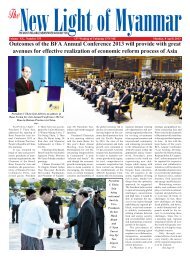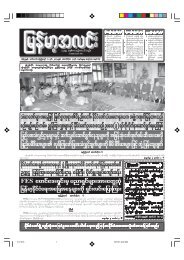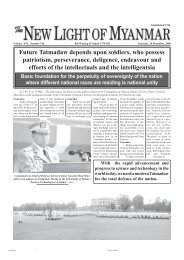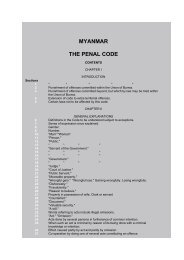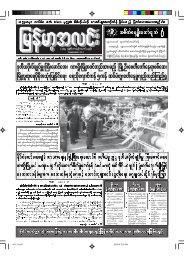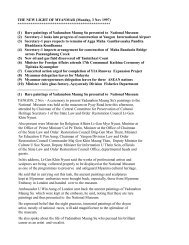Changing Buddhist Practice in Burma - Online Burma Library
Changing Buddhist Practice in Burma - Online Burma Library
Changing Buddhist Practice in Burma - Online Burma Library
You also want an ePaper? Increase the reach of your titles
YUMPU automatically turns print PDFs into web optimized ePapers that Google loves.
particularly oneself, through the <strong>Buddhist</strong> moral, cosmological, and conceptual<br />
framework. The aim of the meditator is to atta<strong>in</strong> the spiritual stage of non-self<br />
<strong>in</strong>volv<strong>in</strong>g understand<strong>in</strong>g the chang<strong>in</strong>g and impermanent nature of th<strong>in</strong>gs,<br />
<strong>in</strong>clud<strong>in</strong>g oneself. 16 Meditation practice is popular among many <strong>Buddhist</strong><br />
Burmese as well as non-<strong>Buddhist</strong>s <strong>in</strong>side and outside <strong>Burma</strong>. In <strong>Burma</strong>, the<br />
Mahasi meditation centre <strong>in</strong> Rangoon is world-renowned and many thousands<br />
of meditators have been tra<strong>in</strong>ed there. In the Mahasi tradition, a person who is<br />
practis<strong>in</strong>g the meditation is called yaw-gi, which can be translated <strong>in</strong>to English<br />
as 'meditator'. In this thesis the term meditator is generally used but yaw-gi<br />
may be used <strong>in</strong> case of direct quotations. Also note that <strong>in</strong> Mahasi tradition,<br />
the term yaw-gi is suffixed to four ma<strong>in</strong> categories: they are monk yaw-gi, nun<br />
(thi-hla-sh<strong>in</strong>) yaw-gi, lay male yaw-gi, and lay female yaw-gi.<br />
Mahasi meditations<br />
The Mahasi Sayadaw of <strong>Burma</strong> systematically developed the practice of<br />
Vipassana meditation, known also as <strong>in</strong>sight meditation, which came to be<br />
identified with new practices of Buddhism focus<strong>in</strong>g on <strong>in</strong>dividual oriented<br />
practice of contemplation. Mahasi Sayadaw states that the mean<strong>in</strong>g and<br />
purpose of the meditation practice, accord<strong>in</strong>g to true Buddha teach<strong>in</strong>g, is<br />
"carried out for the purpose of realiz<strong>in</strong>g Nibbana [nirvana] and thereby<br />
escap<strong>in</strong>g from the ills of life: old age, ill-health, death, and so forth" (Mahasi<br />
Sayadaw 1958:1). 17 In 1958 Mahasi Sayadaw wrote a treatise about the real<br />
purpose of undertak<strong>in</strong>g meditation <strong>in</strong> accordance with the actual teach<strong>in</strong>g of<br />
Buddha, after it was realized that although many thought they knew how to<br />
12







